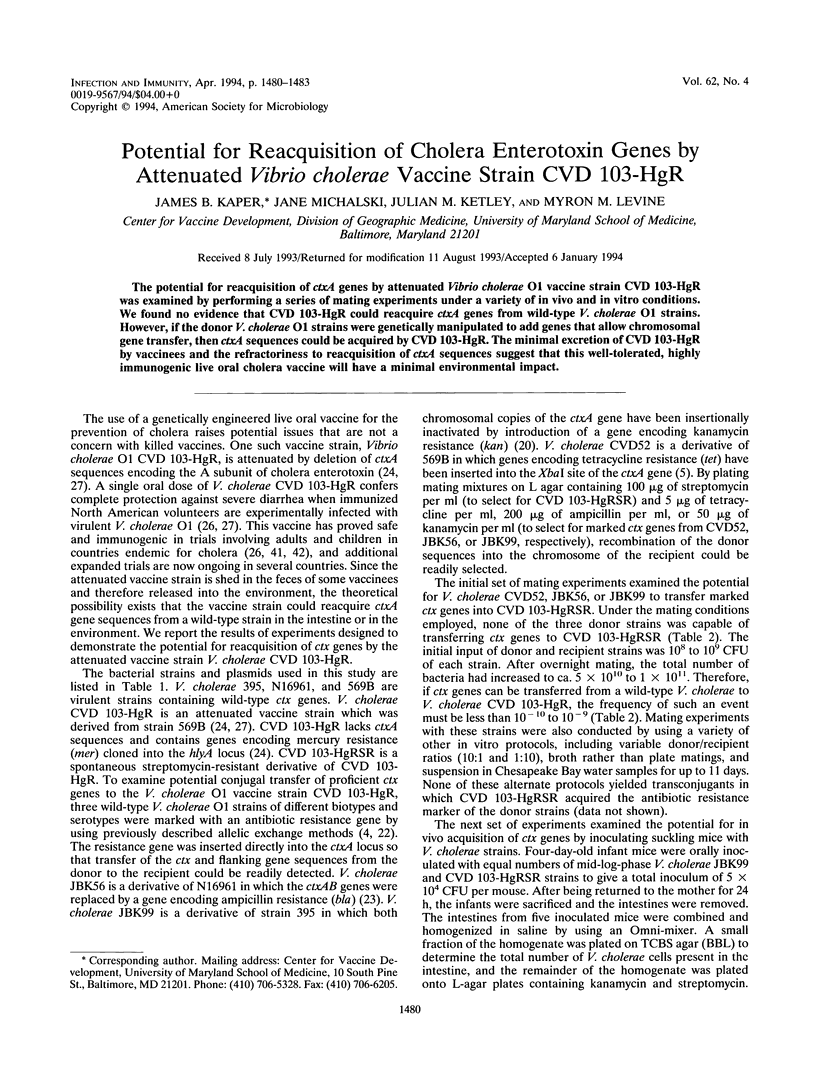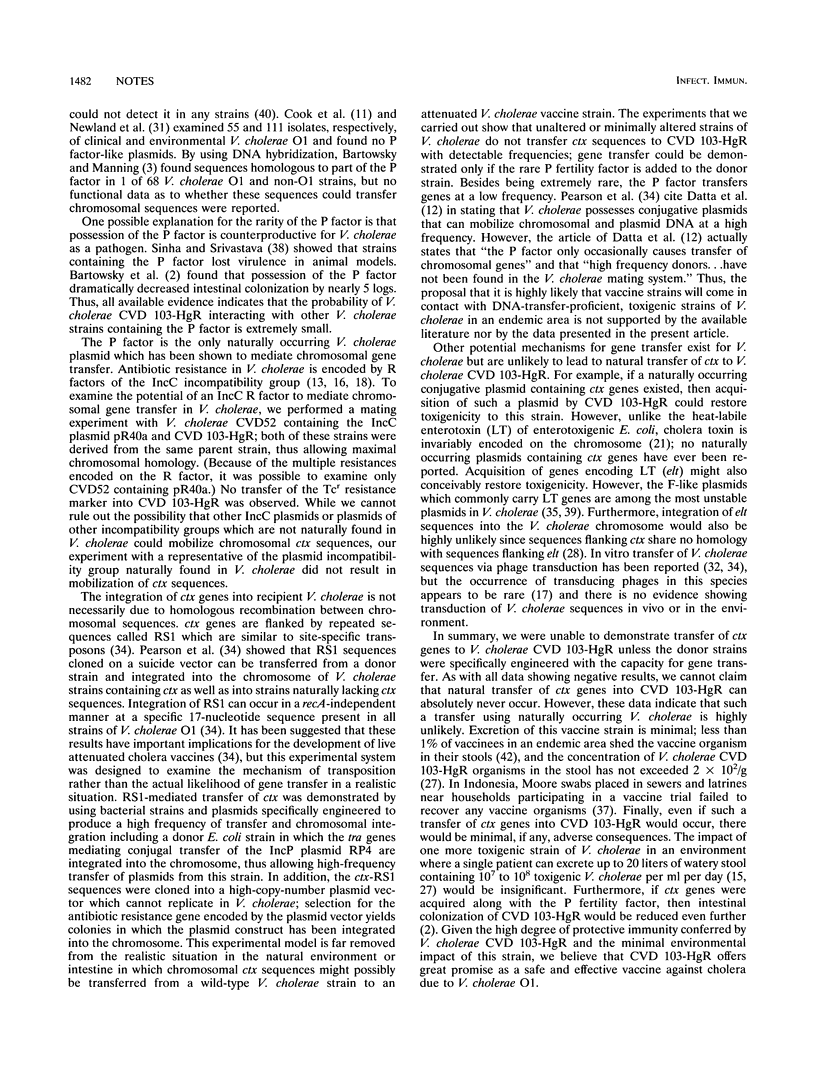Abstract
The potential for reacquisition of ctxA genes by attenuated Vibrio cholerae O1 vaccine strain CVD 103-HgR was examined by performing a series of mating experiments under a variety of in vivo and in vitro conditions. We found no evidence that CVD 103-HgR could reacquire ctxA genes from wild-type V. cholerae O1 strains. However, if the donor V. cholerae O1 strains were genetically manipulated to add genes that allow chromosomal gene transfer, then ctxA sequences could be acquired by CVD 103-HgR. The minimal excretion of CVD 103-HgR by vaccinees and the refractoriness to reacquisition of ctxA sequences suggest that this well-tolerated, highly immunogenic live oral cholera vaccine will have a minimal environmental impact.
Full text
PDF



Selected References
These references are in PubMed. This may not be the complete list of references from this article.
- BHASKARAN K. Genetic recombination in Vibrio cholerae. J Gen Microbiol. 1958 Aug;19(1):71–75. doi: 10.1099/00221287-19-1-71. [DOI] [PubMed] [Google Scholar]
- BHASKARAN K. Observations of the nature of genetic recombination in Vibrio cholerae. Indian J Med Res. 1959 May;47(3):253–260. [PubMed] [Google Scholar]
- Barrineau P., Gilbert P., Jackson W. J., Jones C. S., Summers A. O., Wisdom S. The DNA sequence of the mercury resistance operon of the IncFII plasmid NR1. J Mol Appl Genet. 1984;2(6):601–619. [PubMed] [Google Scholar]
- Bartowsky E. J., Attridge S. R., Thomas C. J., Mayrhofer G., Manning P. A. Role of the P plasmid in attenuation of Vibrio cholerae O1. Infect Immun. 1990 Sep;58(9):3129–3134. doi: 10.1128/iai.58.9.3129-3134.1990. [DOI] [PMC free article] [PubMed] [Google Scholar]
- Baudry B., Fasano A., Ketley J., Kaper J. B. Cloning of a gene (zot) encoding a new toxin produced by Vibrio cholerae. Infect Immun. 1992 Feb;60(2):428–434. doi: 10.1128/iai.60.2.428-434.1992. [DOI] [PMC free article] [PubMed] [Google Scholar]
- Cash R. A., Music S. I., Libonati J. P., Snyder M. J., Wenzel R. P., Hornick R. B. Response of man to infection with Vibrio cholerae. I. Clinical, serologic, and bacteriologic responses to a known inoculum. J Infect Dis. 1974 Jan;129(1):45–52. doi: 10.1093/infdis/129.1.45. [DOI] [PubMed] [Google Scholar]
- Cook W. L., Wachsmuth K., Johnson S. R., Birkness K. A., Samadi A. R. Persistence of plasmids, cholera toxin genes, and prophage DNA in classical Vibrio cholerae O1. Infect Immun. 1984 Jul;45(1):222–226. doi: 10.1128/iai.45.1.222-226.1984. [DOI] [PMC free article] [PubMed] [Google Scholar]
- Datta A., Parker C. D., Wohlhieter J. A., Baron L. S. Isolation and characterization of the fertility factor P of Vibrio cholerae. J Bacteriol. 1973 Feb;113(2):763–771. doi: 10.1128/jb.113.2.763-771.1973. [DOI] [PMC free article] [PubMed] [Google Scholar]
- Finch M. J., Morris J. G., Jr, Kaviti J., Kagwanja W., Levine M. M. Epidemiology of antimicrobial resistant cholera in Kenya and East Africa. Am J Trop Med Hyg. 1988 Nov;39(5):484–490. doi: 10.4269/ajtmh.1988.39.484. [DOI] [PubMed] [Google Scholar]
- Gicquelais K. G., Baldini M. M., Martinez J., Maggi L., Martin W. C., Prado V., Kaper J. B., Levine M. M. Practical and economical method for using biotinylated DNA probes with bacterial colony blots to identify diarrhea-causing Escherichia coli. J Clin Microbiol. 1990 Nov;28(11):2485–2490. doi: 10.1128/jcm.28.11.2485-2490.1990. [DOI] [PMC free article] [PubMed] [Google Scholar]
- Glass R. I., Huq I., Alim A. R., Yunus M. Emergence of multiply antibiotic-resistant Vibrio cholerae in Bangladesh. J Infect Dis. 1980 Dec;142(6):939–942. doi: 10.1093/infdis/142.6.939. [DOI] [PubMed] [Google Scholar]
- Guidolin A., Manning P. A. Genetics of Vibrio cholerae and its bacteriophages. Microbiol Rev. 1987 Jun;51(2):285–298. doi: 10.1128/mr.51.2.285-298.1987. [DOI] [PMC free article] [PubMed] [Google Scholar]
- Hedges R. W., Vialard J. L., Pearson N. J., O'Grady F. R plasmids from Asian strains of Vibrio cholerae. Antimicrob Agents Chemother. 1977 Apr;11(4):585–588. doi: 10.1128/aac.11.4.585. [DOI] [PMC free article] [PubMed] [Google Scholar]
- Jackson W. J., Summers A. O. Polypeptides encoded by the mer operon. J Bacteriol. 1982 Feb;149(2):479–487. doi: 10.1128/jb.149.2.479-487.1982. [DOI] [PMC free article] [PubMed] [Google Scholar]
- Kaper J. B., Lockman H., Baldini M. M., Levine M. M. Recombinant nontoxinogenic Vibrio cholerae strains as attenuated cholera vaccine candidates. Nature. 1984 Apr 12;308(5960):655–658. doi: 10.1038/308655a0. [DOI] [PubMed] [Google Scholar]
- Ketley J. M., Michalski J., Galen J., Levine M. M., Kaper J. B. Construction of genetically marked Vibrio cholerae O1 vaccine strains. FEMS Microbiol Lett. 1993 Jul 15;111(1):15–21. doi: 10.1111/j.1574-6968.1993.tb06355.x. [DOI] [PubMed] [Google Scholar]
- Levine M. M., Kaper J. B., Herrington D., Ketley J., Losonsky G., Tacket C. O., Tall B., Cryz S. Safety, immunogenicity, and efficacy of recombinant live oral cholera vaccines, CVD 103 and CVD 103-HgR. Lancet. 1988 Aug 27;2(8609):467–470. doi: 10.1016/s0140-6736(88)90120-1. [DOI] [PubMed] [Google Scholar]
- Levine M. M., Kaper J. B. Live oral vaccines against cholera: an update. Vaccine. 1993;11(2):207–212. doi: 10.1016/0264-410x(93)90019-t. [DOI] [PubMed] [Google Scholar]
- Mekalanos J. J., Swartz D. J., Pearson G. D., Harford N., Groyne F., de Wilde M. Cholera toxin genes: nucleotide sequence, deletion analysis and vaccine development. Nature. 1983 Dec 8;306(5943):551–557. doi: 10.1038/306551a0. [DOI] [PubMed] [Google Scholar]
- Michalski J., Galen J. E., Fasano A., Kaper J. B. CVD110, an attenuated Vibrio cholerae O1 El Tor live oral vaccine strain. Infect Immun. 1993 Oct;61(10):4462–4468. doi: 10.1128/iai.61.10.4462-4468.1993. [DOI] [PMC free article] [PubMed] [Google Scholar]
- Newland J. W., Green B. A., Holmes R. K. Transposon-mediated mutagenesis and recombination in Vibrio cholerae. Infect Immun. 1984 Aug;45(2):428–432. doi: 10.1128/iai.45.2.428-432.1984. [DOI] [PMC free article] [PubMed] [Google Scholar]
- Newland J. W., Voll M. J., McNicol L. A. Serology and plasmid carriage in Vibrio cholerae. Can J Microbiol. 1984 Sep;30(9):1149–1156. doi: 10.1139/m84-180. [DOI] [PubMed] [Google Scholar]
- Ogg J. E., Timme T. L., Alemohammad M. M. General Transduction in Vibrio cholerae. Infect Immun. 1981 Feb;31(2):737–741. doi: 10.1128/iai.31.2.737-741.1981. [DOI] [PMC free article] [PubMed] [Google Scholar]
- Parker C., Romig W. R. Self-transfer and genetic recombination mediated by P, the sex factor of Vibrio cholerae. J Bacteriol. 1972 Nov;112(2):707–714. doi: 10.1128/jb.112.2.707-714.1972. [DOI] [PMC free article] [PubMed] [Google Scholar]
- Pearson G. D., Woods A., Chiang S. L., Mekalanos J. J. CTX genetic element encodes a site-specific recombination system and an intestinal colonization factor. Proc Natl Acad Sci U S A. 1993 Apr 15;90(8):3750–3754. doi: 10.1073/pnas.90.8.3750. [DOI] [PMC free article] [PubMed] [Google Scholar]
- Rahal K., Gerbaud G., Bouanchaud D. H. Stability of R plasmids belonging to different incompatibility groups in Vibrio cholerae "Eltor". Ann Microbiol (Paris) 1978 May-Jun;129(4):409–414. [PubMed] [Google Scholar]
- Simanjuntak C. H., O'Hanley P., Punjabi N. H., Noriega F., Pazzaglia G., Dykstra P., Kay B., Suharyono, Budiarso A., Rifai A. R. Safety, immunogenicity, and transmissibility of single-dose live oral cholera vaccine strain CVD 103-HgR in 24- to 59-month-old Indonesian children. J Infect Dis. 1993 Nov;168(5):1169–1176. doi: 10.1093/infdis/168.5.1169. [DOI] [PubMed] [Google Scholar]
- Sinha V. B., Srivastava B. S. Plasmid-induced loss of virulence in Vibrio cholerae. Nature. 1978 Dec 14;276(5689):708–709. doi: 10.1038/276708a0. [DOI] [PubMed] [Google Scholar]
- So M., Crosa J. H., Falkow S. Polynucleotide sequence relationships among Ent plasmids and the relationship between Ent and other plasmids. J Bacteriol. 1975 Jan;121(1):234–238. doi: 10.1128/jb.121.1.234-238.1975. [DOI] [PMC free article] [PubMed] [Google Scholar]
- Su-Arehawaratana P., Singharaj P., Taylor D. N., Hoge C., Trofa A., Kuvanont K., Migasena S., Pitisuttitham P., Lim Y. L., Losonsky G. Safety and immunogenicity of different immunization regimens of CVD 103-HgR live oral cholera vaccine in soldiers and civilians in Thailand. J Infect Dis. 1992 Jun;165(6):1042–1048. doi: 10.1093/infdis/165.6.1042. [DOI] [PubMed] [Google Scholar]
- Suharyono, Simanjuntak C., Witham N., Punjabi N., Heppner D. G., Losonsky G., Totosudirjo H., Rifai A. R., Clemens J., Lim Y. L. Safety and immunogenicity of single-dose live oral cholera vaccine CVD 103-HgR in 5-9-year-old Indonesian children. Lancet. 1992 Sep 19;340(8821):689–694. doi: 10.1016/0140-6736(92)92231-4. [DOI] [PubMed] [Google Scholar]


